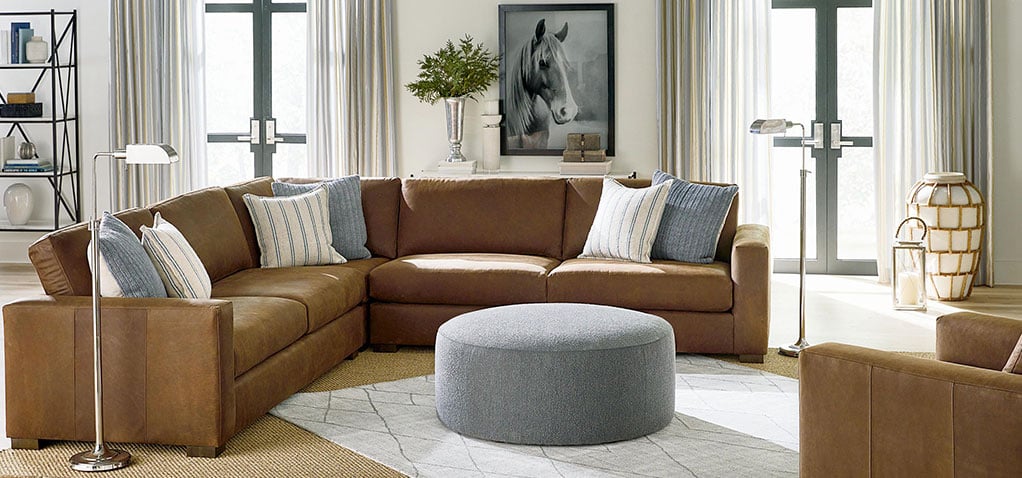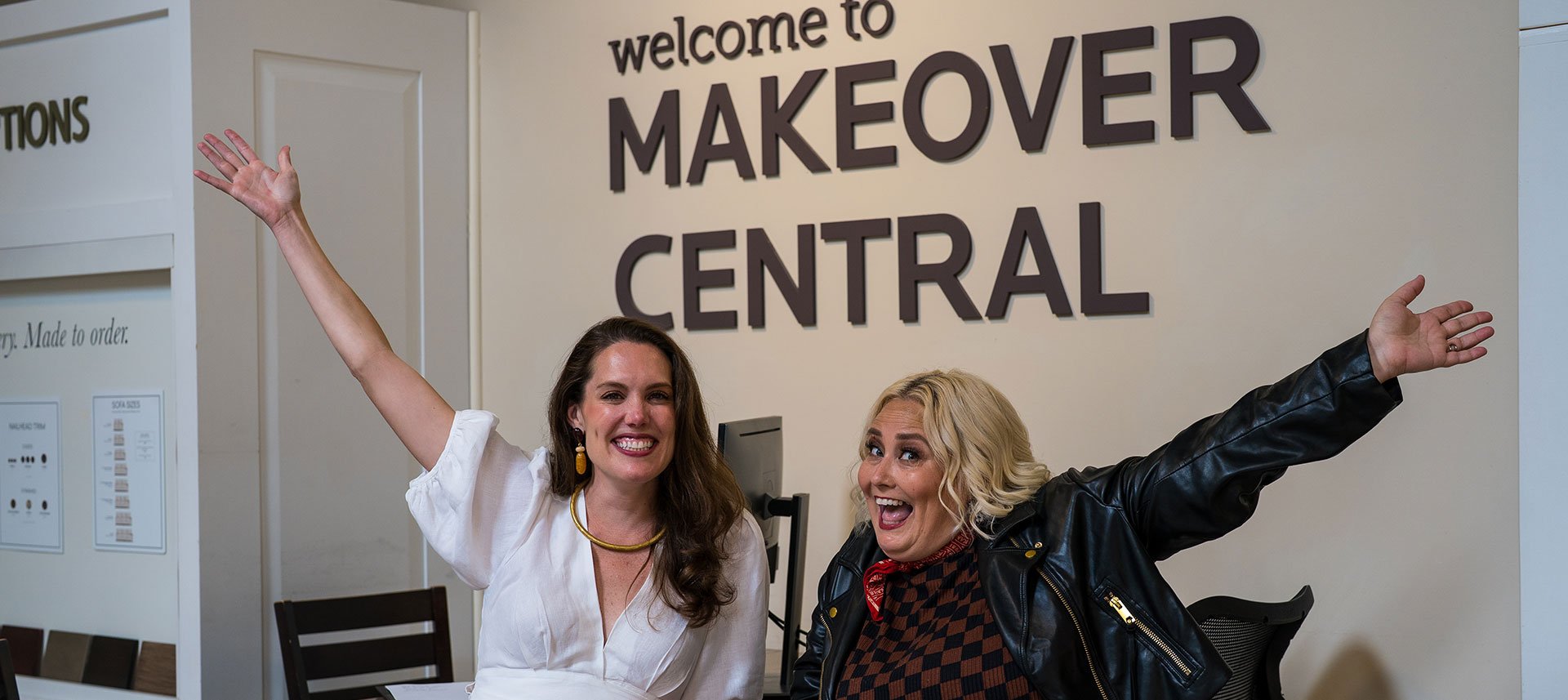Picking a Color
Updated 9/19/22

Creating a home color scheme is so much more than just choosing a paint color or room colour – and it is so much more fun! Whether you let your living room color ideas evolve as you go or try to plan your whole house color palette at once, each room has a color scheme. Choosing the right paint colors can be much easier if you know what color scheme you want to use for your house based on interior colour design and interior design color schemes. Choosing the right paint colors for your home can be much easier if you know what color scheme to use for your interior design project. See our tips on how to choose one here.
How do I choose a color scheme for my house?
Ready to start choosing a paint color? With a few basics of color theory, your palette will emerge in no time.
Creating a color palette
Choosing a color scheme is based on creating a color palette and is much more than just choosing interior house paint color pictures or swatches. A color palette for home design has the power to set the mood for a room and evoke emotions. It can make a room feel warmer or cooler, larger or smaller. Depending on the colors you choose for furniture, walls, window coverings, and accents, you can create balance, harmony, unity, or emphasis.
What Colors Appeal to You?
What colors are you usually wearing when you receive compliments on your appearance? Do you want the room to be a place of relaxation? Or will it be used more for entertainment and social interaction? Do you need to make the room look bigger, more open? Or do you need to make the room look smaller and cozier? Use these questions as a starting point to put together the most meaningful living room color ideas for you.
Cool vs. warm colors
One of the first choices in decorating is to decide whether you prefer warm vs. cool colors. There is no right or wrong when choosing house color schemes interior because the debate over warm vs. cool colors comes down to a matter of preference.
If you are working on a project, some information on warm and cool colors and how to use them can help you narrow down the decision.
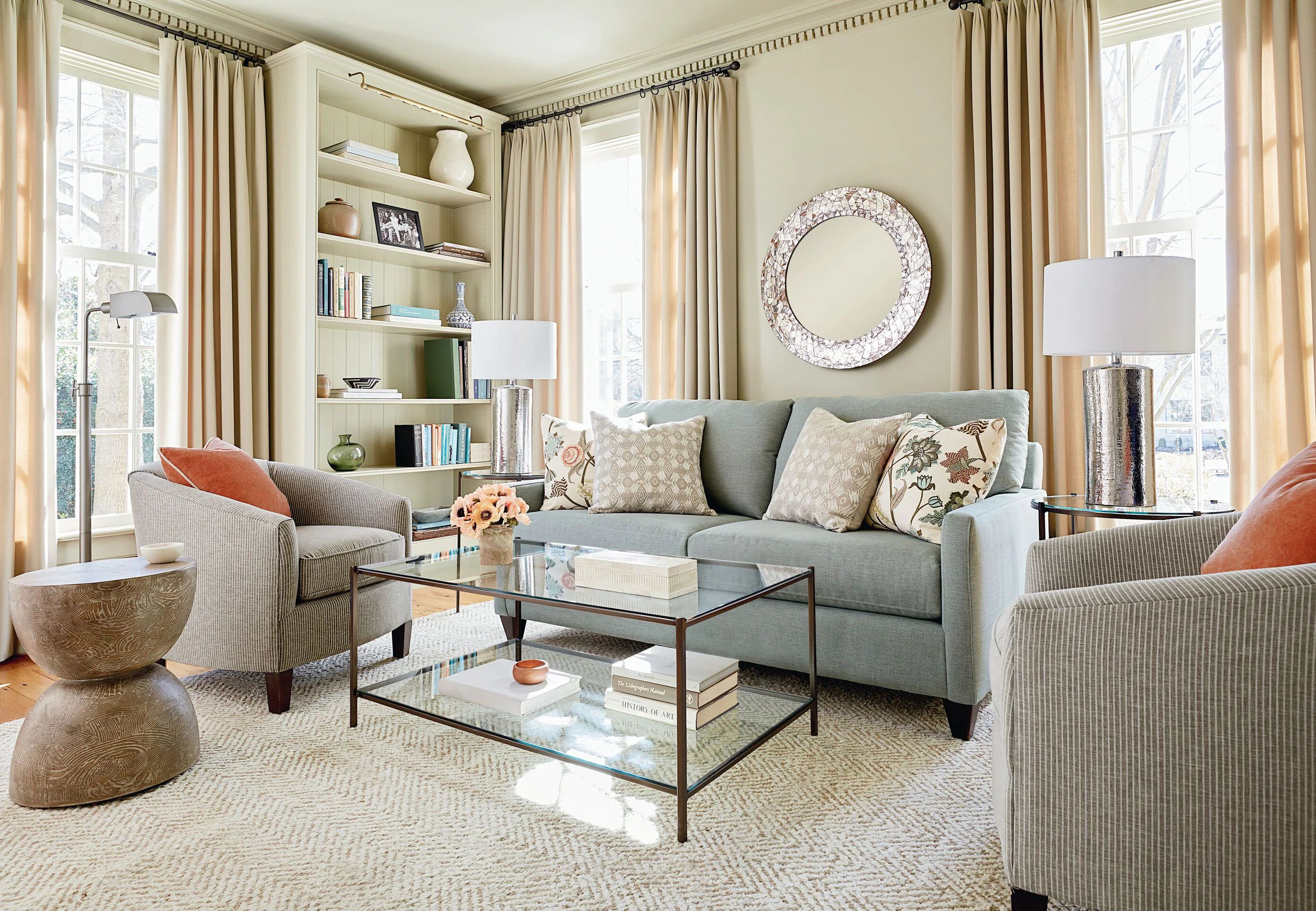
Warm colors and cool colors
In color theory, the discussion of warm and cool colors has been important since the 1700s. Warm colors range from yellow to red, often including browns. Cool colors range from blue-violet to blue-green, often with some grays included. In art and design, warm colors appear to be more active, while cool colors recede.
Warm and Cool Colors:
• Warm colors: Warm colors are derived from the primary colors red, orange, and yellow; they evoke a warm feeling reminiscent of fire-like elements like the sun.
• Cool colors: Cool colors are derived from the primary colors violet, blue, and green; they evoke a cool feeling reminiscent of earth elements like water or greenery.
Color temperature
Measured in kelvins, color temperature is a light characteristic important to science and design. Cool colors have are blue(ish) and have a higher color temperature of over 5000 k. Warm colors are yellow(ish) and have color temperatures below 3000 .
Using the color wheel
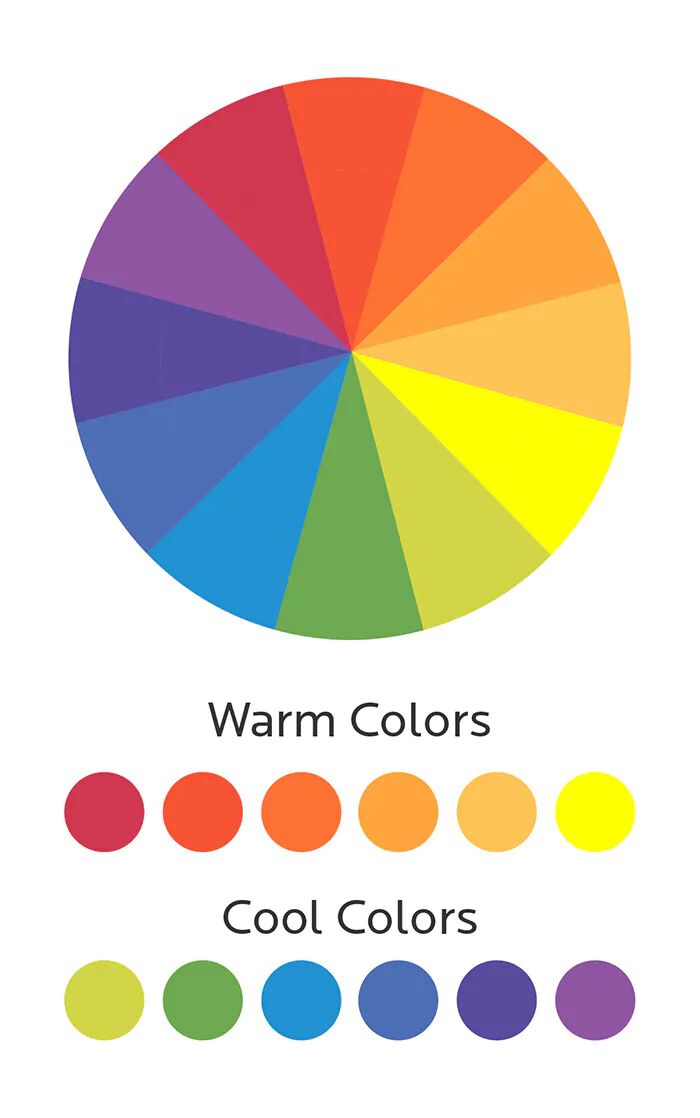
Since it does not explain green or purple in terms of color temperature, we use a color wheel to describe all colors on the spectrum. The color wheel can be divided into two halves. As you can see in the figure on the right, this color wheel has 12 colors, with warm colors on the right and cool colors on the left. Below the color wheel, the colors are broken down into parts.
Warm colors
This section gives an overview of warm colors, discussing the following:
• What are warm colors?
• Warm colors on the color wheel
• A warm color wheel
• Is brown a warm color?
• Warm neutral colors
• Warm colored rooms
• Warm and inviting colors (7 examples)
What are warm colors?
Warm colors have characteristics such as vivid, bright, bold, and sometimes overwhelming. Warm colors have a lower color temperature that ranges from 2700 kelvin to 3000 kelvin. Warm colors recall fire, the sun, and heat and generally have red or yellow undertones.
Warm colors on the color wheel
The main warm colors on the color wheel are red, orange, and yellow. Colors that are solely made up of a mixture of these colors are, without any dispute, warm colors. Like magenta with a blue bias, other colors look like a warm color but are actually a cool color.
A warm color wheel
If we were to make a purely warm color wheel, its primary colors would contain red, orange, and yellow, with numerous mixtures of those three colors. Ultimately, as the color wheel drifts over farther into the deep red part of the spectrum, it will start to drift into the cool (blue) color territory.
Is brown a warm color?
Because it is made of wood, the most common color in furniture is brown. While brown is considered neutral on its own, it is often grouped with warm colors because it complements them well; also, "warm browns" can have a warm color bias when brown is mixed with a warm base. Common "warm browns" are used concurrently with autumn red, orange, and yellows.
Warm neutral colors
While brown is considered a neutral color, it often seems more warm than neutral when mixed with warm colors. This is not the case for grey or green. When warm colors are lightly added to grey and sometimes grey with a green tint, you get what many consider "warm neutral colors." Warm neutral colors feel more neutral than warm but still have more of a warm bias than a cool one.
Warm colored rooms
Warm colors are the king of cozy. Below are some warm home colors that can add a warm and inviting flair to your project if used in the right circumstances.
Warm and inviting colors
• Red: Just a hint more warm-biased than magenta, a deep, rich red can bring warmth to a seasonal project (or any for that matter).
• Peach: Sometimes, peach can be tasteful and inviting when combining all of the warm color spectra.
• Pink: If used tastefully in its more subdued form, Pink can be a bold statement that can be vigorous and inviting at the same time.
• Tangerine: Tangerine in its purest form has more of a pumpkin tint than pure orange. This color can be great for autumn.
• Gold: Darker than the standard yellow, gold, or even mustard yellow, feels warm and inviting without overly exuberant.
• Brown: As discussed above, brown is a neutral color that complements warm colors well, especially if mixed with a deeper warm color.
• White: While white is the quintessential neutral color, a creamy, warm white can be among the coziest of warm colors in the right circumstances.
Cool colors
This section discusses cool colors, namely these topics:
• What are cool colors?
• Cool color wheel
• Cool colors recede
• Cool house colors
• What are some cool colors?
What are cool colors?
On the other side of the color wheel, we have cool colors with blue undertones. Cool colors are the colors of ice, water, sky, and grass. In design, cool colors tend to be calming, relaxing, and soothing, and they tend to recede. Pillows can tie a color scheme together.
Cool color wheel
Examples of cool colors include violet (purple), blue, and green. You can make your own cool color wheel by using only these three colors as the primary colors while using various mixtures of these colors as your secondary colors. Limiting yourself to a cool color wheel can be a useful exercise in color theory, as it is difficult to create any accent tone without a warm color present.
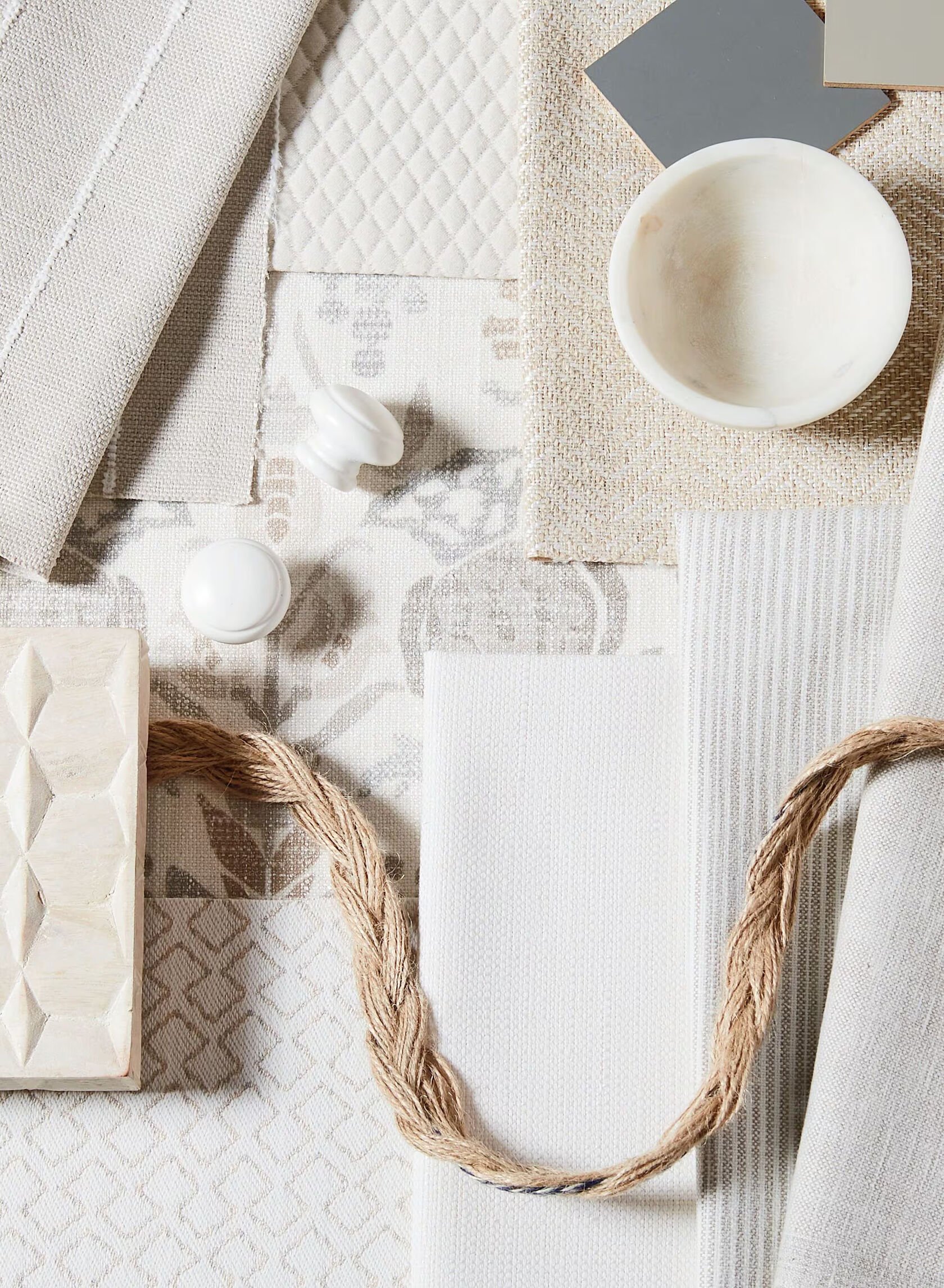
Cool colors recede
Cool colors will appear to recede (think Van Gogh's "Starry Night"). Cool colors seem to recede in space because blue, the primary undertone of cool colors, has shorter wavelengths than other colors. While a blue figure, or any figure based in primary colors, may take up the same space as any other color, they make the space seem larger because of the smaller wavelength.
Cool house colors
When used in a home décor project, cool colors can be calming when used alone. They can also be used as accent colors for rooms with a warm color bias.
What are some cool colors?
• Sage: A calmer alternative to grey and more emotional than white, sage is a green-based color that adds a soothing feeling to a room.
• Deep Purple: Midway between magenta and violet, deep purple goes well with warmer blues. This can be a great accent color.
• Navy: Navy blue is a timeless dark look that goes extremely well with neutral accents. Mixing navy with a grey or deep purple can give you an all-cool space with many flairs.
• Beige: While beige is often considered a neutral color (like brown), cool beige is a trendy version of beige with a pink base.
• Grey: The definition of neutral, we chose grey to be on the list of cool house colors because it is perhaps the best color out there to accompany any other cool color on this list.
• Green: Earthy and grounding, green is a fresh and lively cool color that makes your space feel bold but natural.
• Light Blue: Still technically characterized as a cool color, light blue is a bright cool color that can be calming and enlivening.
Warm vs. cool colors
It’s no mistake! You absolutely can create a beautiful design by mixing warm and cool colors in your room. It’s kind of like planning a buffet with sweet and spicy dishes – the key is to add in another flavor. When you’re talking about mixing warm and cool colors, that other “flavor” is neutral.
Cool neutral colors
Neutrals are colors that aren’t included on the color wheel. Shades of browns, tans, golds, beige, and black are usually considered warm neutrals, while shades of white, cream, ivory, gray, and silver are usually considered cool neutrals. To complicate matters a bit, many neutral color families (like brown) can actually be warm or cool, depending on the proportion of yellow or blue tones in the mix.
Warm-cool colors
A "warm-cool color" is a color that blurs the lines between warm and cool to the point where you can't discern whether it is warm or cool. Magenta, as mentioned earlier, is an example of a warm-cool color. While technically cool, magenta is a color that feels warm. Using a mixture of blue and red, both on the opposite sides of the color wheel, magenta is a color that seemingly transcends the color spectrum.
Cool or warm undertones?
If a color has cool undertones, it will lean gold or yellowish. Something will cool undertones will leak red or blue. For this reason, a mixture of red and blue, the quintessential colors of the warm and cold sides of the spectrum, respectively, will give (sometimes) give you color with the opposite undertone.
Color schemes
Based on the color theory principles we just looked at, below are some ways to create high energy color schemes based on the color wheel:
Mixing cool and warm colors
Using a three-color design scheme, you can apply the “rule of three” when mixing warm and cool colors. In other words, divide the colors into components of 60 percent of a dominant color (applied to the walls), 30 percent of a secondary color (mainly in upholstery), and 10 percent of an accent color (like in accessories or an accent wall). Which color should be dominant? Whichever color you love the most - as long as it’s one you can live with.
The three basic color schemes for your house below are listed from lowest to highest “energy”:
A monochromatic color scheme means the colors are all shades or tints of the same hue, like all grays or blues.
An analogous color scheme uses three colors or hues neighboring each other on the color wheel, like orange, red, and yellow, or blue, green, and yellow. The colors don’t need to be strictly adjacent to each other.
A complementary color scheme means the colors are opposite on the wheel, with one warm color and one cool color.
What Type of Light Does The Room Get?
Also, consider the natural light in the room when you're choosing a color scheme for your home.
• North-facing rooms are the darkest, receiving diffuse light most of the day. This light is cool and bluish, which means cool colors will look even cooler, and whites will look grayish. Bolder colors show up better than muted colors. Warm colors, or lighter colors that reflect rather than absorb light, may be a way to brighten the room.
• East-facing rooms receive early morning light. This light appears warm yellow or gray before noon and then turns bluer later in the day. Bright morning light tends to wash out colors. Blue greens and cool neutrals come to life in the morning light and retain their vibrancy as the day progresses. If the room is used in the late afternoon, warm colors will help balance the lack of light.
• South-facing rooms receive late morning and early afternoon light. Lots of high-in-the-sky light brings out the best in cool and warm color schemes. Dark colors will look brighter, and lighter colors will glow.
• West-facing rooms receive strong late afternoon light, a golden warm light that can be intense. In the morning, west-facing rooms are shadowy. You can use light-reflective cool colors to balance the warmth or go with a hint of warm red if the room is used in the morning.
What Elements Should I Choose First?
It’s easiest to create a color scheme for your home design if you start with a certain color and then work your room around that. Resist the temptation of choosing a paint color first! Instead, find a more long-term investment that you love, like furniture, fabric, or tile. If you have patterned upholstery, a colorful rug, or a large piece of artwork you love, pick colors from that. Remember to consider your wood finishes as well. It is much easier to find a paint that works with the fabric than the other way around. You can change accent wall colors in an afternoon with a small investment in a pail of paint.
Playing with Pattern Sizes
Accent fabrics that incorporate your home color palette are a great way to tie everything together in a way that looks intentional. You can create rhythm in a color scheme by repeating a color in various places throughout the room. Choose fabrics that use the same color family but in varying pattern sizes.
The weight of fabric and smoothness also affect how color appears. Fabrics with smooth textures reflect more light, giving them lighter visual weight. Fabrics with coarse or rough textures absorb light rather than reflect it and make items look heavier.
Light and airy color schemes
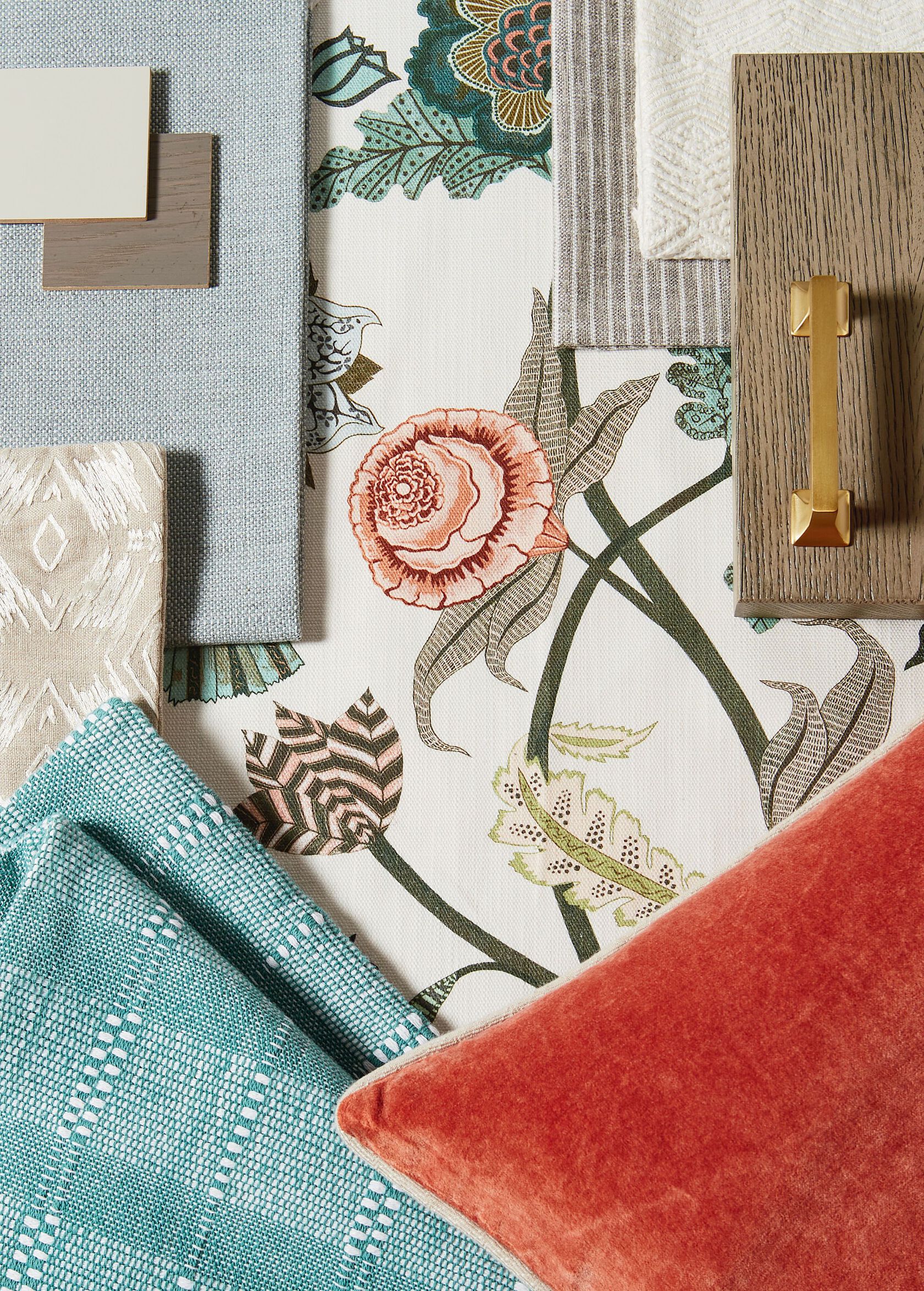
Sunny with a side of light and airy? If that’s in your décor forecast, you’ve come to the right place. The right combinations of colors (and lack of them), lightweight materials, lighting, rugs, and accessories can create that oh-so-simple yet comfortable aesthetic you’re seeing on social media – and wanting for your own home.
This season, changing floorplans and adding windows may not be on your to-do list, but you can learn how to brighten a dark room by following a few simple steps.
Paint clean and light colors.
Light doesn’t have to mean “white,” but you really can’t go wrong with it in any room. It creates a canvas or backdrop for everything else in your room. If you’re not completely sold on white, try a whisper of green, blue, yellow, or even lavender. Pale neutrals will set the mood too. Showcase a few pieces of artwork for the walls and frame them simply; artwork should be large enough to hold their own on the wall yet not be overwhelming.
Add a dash of bright color.
Apply the 90/10 rule: use 90 percent white (or whichever light color you’ve chosen) throughout your room and add a dash (10 percent) of bright and happy colors. (Greens or blues, anyone?) Whatever you do to brighten up your dark rooms, go with your gut. You can always rely on stately black accents, too, for turning up the level of sophistication.
Let the sunshine in.
We aren’t all lucky enough to have skylights, or bay windows, or even big windows for that matter, but make the most of what you have. Banish the bummer heavy drapes and opt for cheery sheers instead. Need more coverage at nighttime? Plantation shutters offer the best of both worlds with just a nudge on the tilt rod: a chandelier, wicker ceiling fan, or even white ceiling fan blades.
Delight in lighter fabrics and furnishings.
When brightening a dark room, dark, thick fabrics (and leathers) need to exit stage left now to make way for the stylish Beckham and versatile Exeter sofa and sectionals in light-colored or muted patterns. Bookshelves can take on a more modern, artsy look by removing volumes and placing a few personal objects around artfully. Generously scaled Pippa accent chair and ottoman have light-hearted spool style legs. For a cocktail table, console, or media console, warm and charming Bluffton is the way to go. In the bedroom, you can lighten up heavy-looking furniture like the bed simply by removing the footboard to add more openness to the room; likewise, choose tall, narrow pieces of furniture (think Bella Collection) over wider pieces to give the appearance of extra roominess. Light-colored woods and painted furniture (again, think Bella Collection) has a much-coveted vintage market look. There’s a bookcase, writing desk, buffet and lots more. Neo-traditional with a modern twist, Ventura bedroom pieces combine crisp finishes with handsome accent details.
What’s underfoot?
What kind of flooring do you have? White or some kind of light-colored flooring or carpeting is ideal, while hardwoods of any color will provide that much-needed organic feel. An area rug can serve to brighten up dark rooms, too, as well as a textured or patterned rug if you choose.
Go au naturel.
Speaking of organic, by all means, go au naturel. Touches of green and anything living will ground your room with a modern earthiness. A potted plant will work wonders.
Eliminate clutter and mess.
At all costs, declutter your room and unravel that mess. Kill the knickknacks. Show only the pieces that are useful or that you just adore. Nothing says “zen” like a carefully placed storage basket keeping all the loose ends at bay.
Mixing wood furniture with white
White walls and wood furniture are a classic combination that never seems to go out of style. However, when it comes to mixing wood tones with white, getting your space to look just right can be challenging. Here are five tips for mixing wood furniture with white.
Incorporate different textures
By incorporating woods with different textures, you can mix various wood tones while still keeping the design fresh. For example, if you have smooth hardwood floors, try adding distressed wood furniture into your design.
Stick to common undertones
Matching wood finishes can be a little heavy in a room, even with white walls. Look for wood furniture pieces that complement each other but don't match. If the undertones in your floors are warm, look for wood furniture with warm undertones.
Contrast dark with light
White walls look great with just about any color of wood furniture. But they look really great when the wood furniture is dark enough to create a stark contrast. Creating contrast is also a great way to mix different wood tones. If your floors are light, dark wood furniture will stand out and vice versa.
Mix it up.
Mixing wood furniture and white is restricted to white walls. Try mixing a white couch with a wood panel accent wall or a wood coffee table with white end tables. Mixing white and wood tones is a great way to combine natural and modern decor without looking mismatched.
Don't stress
When it comes to mixing wood furniture with white, you really can't go wrong. White is a blank canvas that you can really pair with anything. Just be cautious when mixing different wood tones, and you should have no problem creating a room that looks as cohesive as it does beautifully.
Best furniture for grey walls
Grey has replaced white as the "it" color for walls in any room. And just like white, grey is a versatile color that goes with just about anything. When it comes to the best furniture for gray walls, you really can't go wrong, but here are a few of our favorite grey paint and furniture combinations.
Grey Walls + Grey Furniture
You might think pairing grey walls with grey furniture would be too much, but the living room above proves that theory wrong. Grey walls in a medium tone pair perfectly with a light gray sofa, dark gray rug, and dark grey furniture. Even the accent chairs incorporate light stripes of grey. The trick here is mixing greys and mixing patterns. There isn't a single shade of grey or pattern that overwhelms the room, which keeps it from looking too dark.
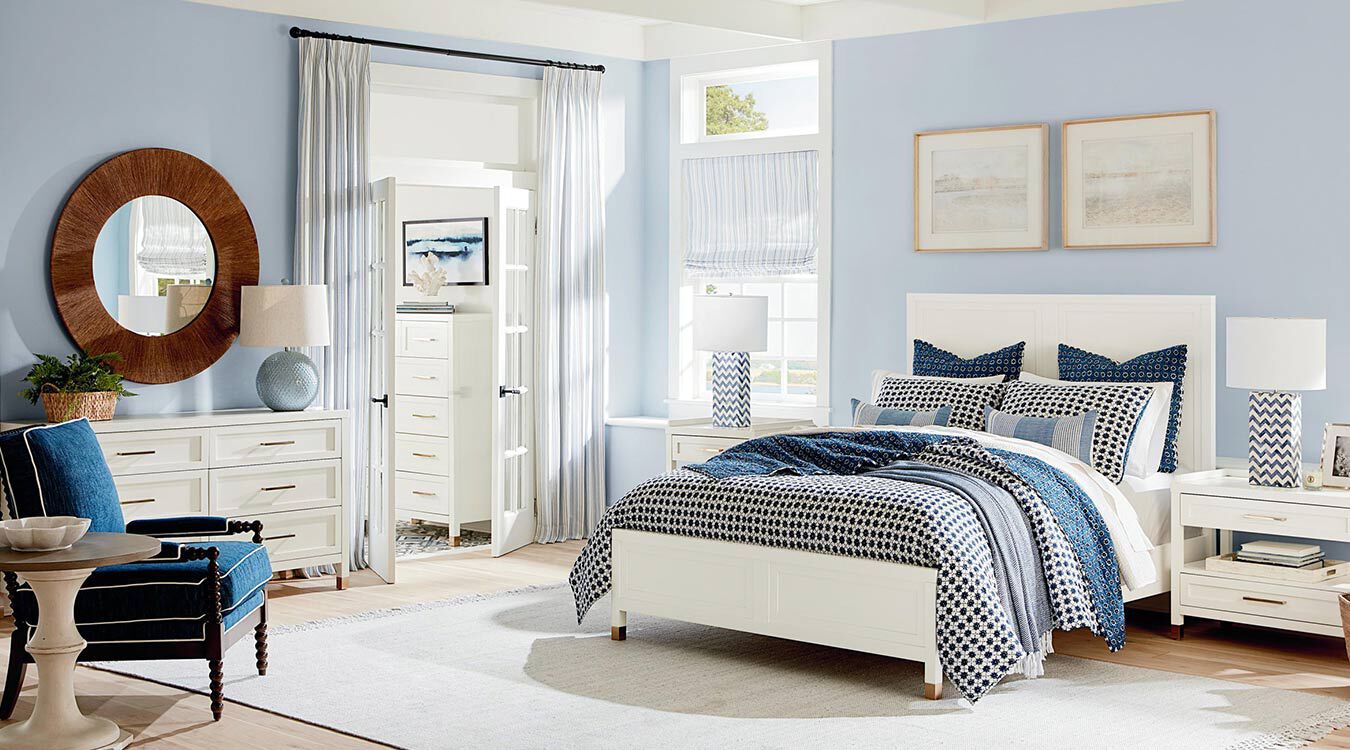
Grey Walls + White and Black Furniture
Combining dark grey (almost black) walls with white trim creates a striking contrast echoed in the furniture in this dining room. A white and grey patterned rug breaks up the repetitive color scheme, and the white fabric on the chairs contrasts the black table and chair legs to keep the room from looking too dark. Add a colorful centerpiece, and you've got an elegant yet modern dining room.
Grey Walls + Wood Furniture
Light grey textured walls look great with medium-tone wood furniture and metal accents. It's industrial meets traditional in the best way possible. When pairing light grey and wood, mix all the textures you want. Just make sure to keep the other accents, such as pillows, blankets, side tables, and light fixtures, light in color.
We are the color experts.
So how will you create a color scheme for your house's design? There are no absolute rules, of course. If there were, everyone’s living room color ideas would be the same! It’s best to go with what appeals to you the most. See one of our design consultants for friendly suggestions for your home color palette or find elements that make your home come alive.
